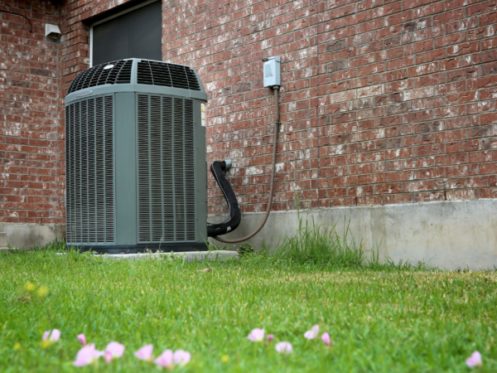There are multiple ways to heat your Edmond, Oklahoma home, including boilers, furnaces, and heat pumps. Heat pumps are currently attracting a tremendous amount of attention due to their efficiency and the low cost of using them. Read on to find out what heat pumps are and how they differ from typical HVAC systems.
Combustion-Based Heating Systems
Although there are electric boilers and furnaces, most homeowners in Oklahoma have heating systems that rely on combustion. Whether your home heating equipment uses oil or gas for fuel, and despite the fact that electricity powers its ignition switch and other internal components, combustion is what drives its operations. Whenever you turn your heating system on, it burns fuel to produce heat. Unfortunately, furnaces and boilers don’t burn fuels completely. This is what creates the exhaust gases that must be vented to the outside of your home. It’s also what creates the risk of carbon monoxide (CO) exposure and poisoning. Incomplete fuel combustion additionally accounts for energy waste.
Although oil and gas-fired furnaces are now produced with fairly high levels of efficiency, their maximum efficiency ratings are only applicable with proper installation and maintenance. Moreover, even with these things, the efficiency of boilers and furnaces gradually declines as they age.
How Heat Pumps Do Their Job
Heat pumps provide warm air using an entirely different method. Unlike oil and gas-fired furnaces, they don’t actually produce heated air. Instead, they simply move it. Heat pumps work much like air conditioners do. The only difference is that they can operate in reverse. Air conditioning systems transfer warm air from inside the home outdoors. Heat pumps harvest warm air from outdoors and then pump it inside. Both systems use refrigerant to facilitate heat transfer. Moreover, neither equipment type produces exhaust gases. If you have a heat pump in your home, you don’t have to worry about having gas leaks affect resident health.
Heat Pumps Are Incredibly Efficient
Although they don’t use gas or heating oil to generate heat, heat pumps do require energy. These systems are powered solely by electricity. In ideal conditions, it’s estimated that heat pumps are capable of transferring 300% more energy than they consume. Even if this is a generous estimate, it’s obvious that heat pumps are considered far more efficient than even the best-rated boilers and furnaces.
Heat Pumps Free up Indoor Space
Homes that have separate heaters and air conditioners sacrifice considerable amounts of space to house their HVAC equipment. For instance, the typical furnace is installed indoors and must have a minimum of 30 inches of clearance at all sides. Air conditioners have both indoor and outdoor units. To prevent overheating, air conditioners must have adequate clearance around their perimeters as well. Comparatively, heat pumps have just a single, outdoor unit. Moreover, outdoor heat pump condensers only need 25 inches of clearance at all sides. Thus, if you ditch your central furnace and your central AC system, you’ll have more room for storage or other needs.
Heat Pumps Can Work in Reverse
Another major benefit of heat pumps is the fact that they’re multi-functional. If you have a furnace or boiler in your home, you’ll need a second set of equipment for summer cooling. If you don’t have central air conditioning, you may be relying on an inefficient window AC or a swamp cooler. With a heat pump, you’ll get everything you need in a single unit. In winter, your heat pump will move outside heat into your home. In summer, it will move inside heat outdoors. By reversing your heat pump’s operations, you can turn this system into a highly efficient cooling unit within just seconds. You’ll also have less equipment to maintain and more usable space in your home overall.
Understanding the Limitations of Heat Pumps
So far, heat pumps probably sound pretty amazing. However, they do have their limitations. Heat pumps can source outdoor heat and transfer it indoors even when the outside air is downright cold. In fact, heat pumps remain efficient in heat transfer when outside temperatures fall as low as 40 degrees Fahrenheit.
Although these units can continue the heat transfer process in colder conditions, they become increasingly less efficient the lower that temperatures fall. Thus, if you rely exclusively on a heat pump for winter warmth, there may be times when your heat pump runs non-stop and the temperature of your living environment remains less than ideal. This shortcoming makes heat pumps a poor choice for a standalone heating solution in any region that regularly has below-freezing temperatures.
Different Options in Heat Pumps
Heat pump limitations are determined in part by the type of heat pump you own. Air-source heat pumps are the most common choice for residential applications. These units source heat from the outside air. Much like their name implies, ground-source heat pumps source heat from the ground. These units can continue supplying adequate heat even when outside temperatures fall well below freezing. However, they can be costly to install and they aren’t a feasible choice in all areas. There are also water-source heat pumps that extract and dissipate heat via water. To have a water-source heat pump installed, homeowners must have legal access to a nearby lake or other body of water.
Why Are Heat Pumps So Popular?
The efficiency of heat pumps is their most impressive attribute. Transferring heat uses far less energy than actually producing it. With no exhaust gases and units that sit outside, heat pumps save indoor space and eliminate the risk of carbon monoxide poisoning. They’re also a lot easier to care for given that homeowners have just a single piece of equipment for both heating and cooling. Moreover, as more consumers come to value efficient and environmentally friendly appliances and systems, installing a heat pump in your home is increasingly becoming a great way to boost its marketability.
Is a Heat Pump the Right Choice for Your Home?
Residents of Edmond, Oklahoma enjoy winters that are both shorter and less severe than the winters of other Great Plains states. The average winter low in Edmond is 31 degrees Fahrenheit. Moreover, winter temperatures rarely drop below 17 degrees. Thus, a heat pump will perform at maximum levels of efficiency throughout the majority of the cold season. According to some reports, its efficiency levels could be as high as 300%.
However, when temperatures plummet, heat pumps will experience progressive decreases in both efficiency and performance as they struggle to source heat from an increasingly cold environment. For this reason, we often recommend having a backup heating source to support heat pumps. Heat pumps tend to be most suitable for use as primary heating systems in areas with mild winters and virtually no risk of below-freezing temperatures. Heat pumps are reliable sources of indoor cooling during the summer months, but they’re likely to struggle with heat transfer right when consumers need them the most.
At True Climate Heat + Air, we’re committed to helping residents of Edmond, Oklahoma save money by making informed heating decisions. We offer heating, cooling, plumbing, and indoor air quality services. We also provide preventative maintenance plans. To schedule an appointment, give us a call today.


